At a whole centre meeting, the Flexibility team discussed the time and timing of energy demand, creating postcards to capture their ideas.
Whole centre workshop, September 2019
The CREDS programme includes projects that work across times scales ranging from seconds to centuries and that investigate the timing of energy demand during the day, over the week or across the year.
Since matters of time and timing are central to the energy demand agenda, it made sense to organise a whole centre workshop devoted to this topic. A reading pack, including participants’ own written contributions interspersed with texts from different disciplines, provided a common point of reference, inspiring and informing detailed discussion of the temporalities of demand.
Towards the end of the workshop we invited participants to capture some of the ideas and thoughts that had been generated along the way, and set them down in the form of a postcard written to a fictional friend or colleague who could not make it to the event itself. Since these are quite literally the messages arising from the event, we reproduce a selection of them here, heavily edited with a wider audience in mind.
Postcard 1
Issues of sequence, synchronisation, speed and rhythm proved to be as important for those who study energy demand in buildings as they are for experts in transport and energy policy. As the first postcard demonstrates, talking about these themes brought new questions into view.
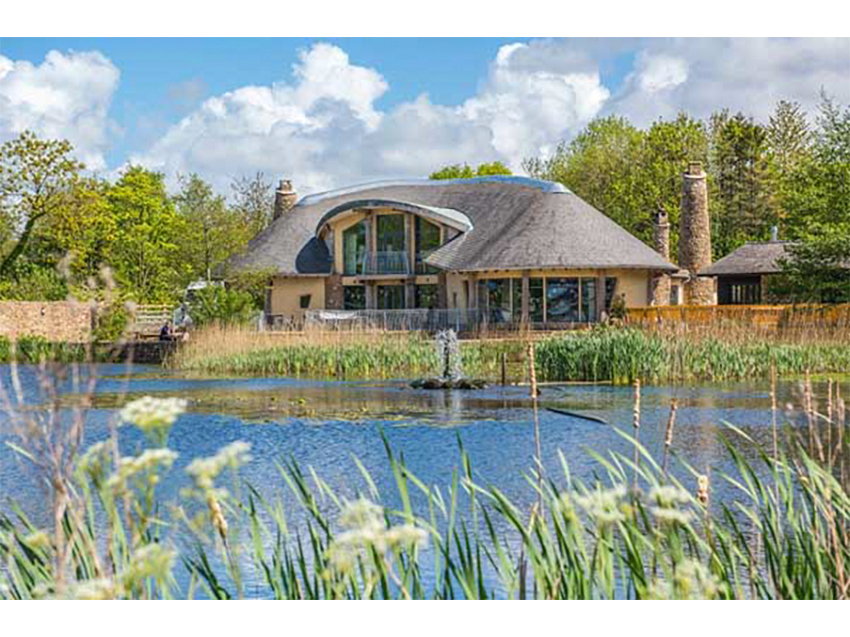
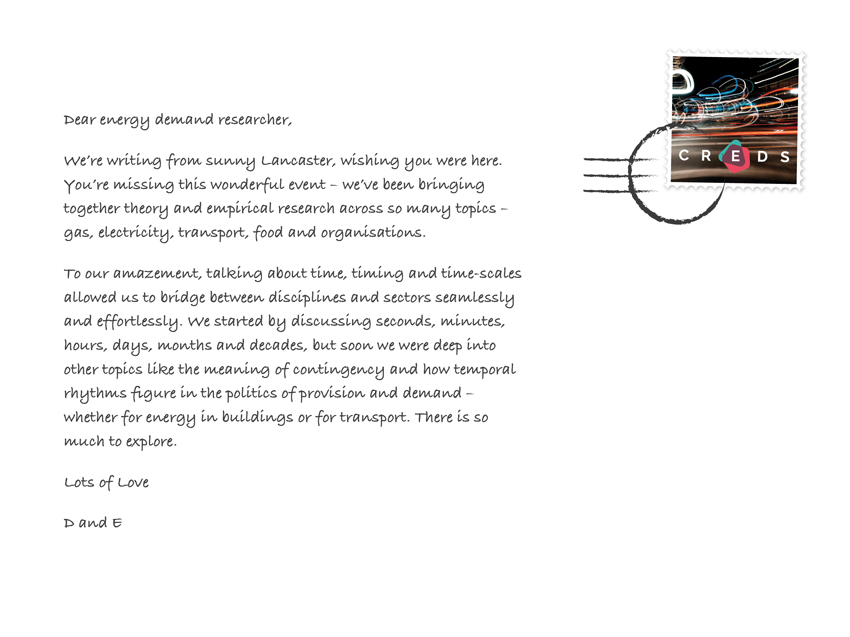
Text for postcard 1
Dear energy demand researcher,
We’re writing from sunny Lancaster, wishing you were here. You’re missing this wonderful event – we’ve been bringing together theory and empirical research across so many topics – gas, electricity, transport, food and organisations.
To our amazement, talking about time, timing and time-scales allowed us to bridge between disciplines and sectors seamlessly and effortlessly. We started by discussing seconds, minutes, hours, days, months and decades, but soon we were deep into other topics like the meaning of contingency and how temporal rhythms figure in the politics of provision and demand – whether for energy in buildings or for transport. There is so much to explore.
Lots of Love
D and E
Postcard 2
The second postcard suggests that interpretations of normal provision (of energy and of transport) are not just about what services should be provided: they are also about when those services are available. As the authors notice, ideas about appropriate timing are tied up with a whole range of institutional policies.
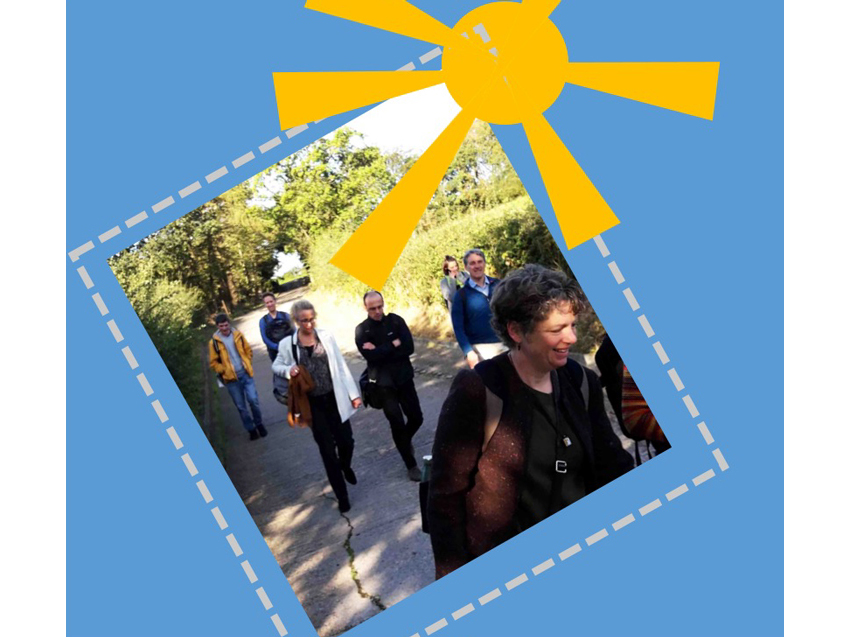
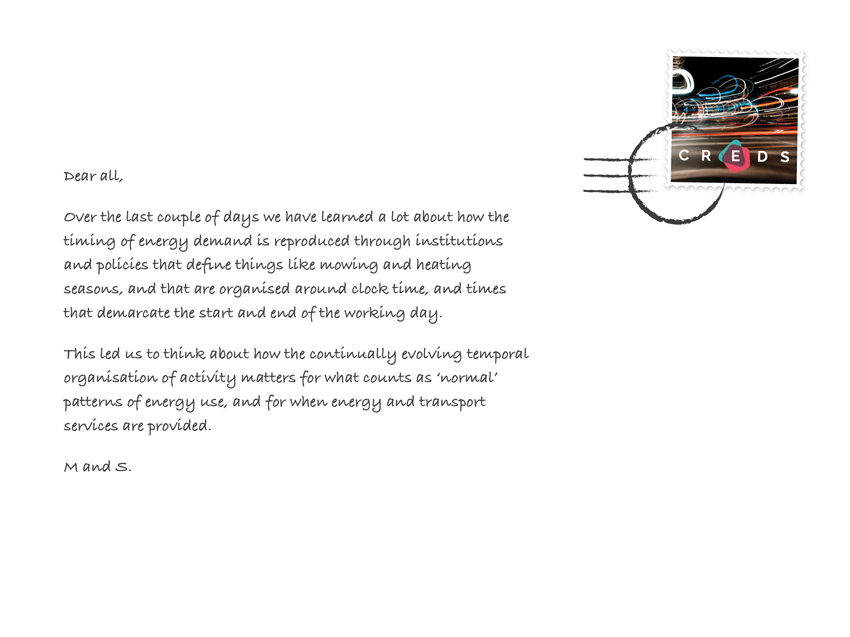
Text for postcard 2
Dear all,
Over the last couple of days we have learned a lot about how the timing of energy demand is reproduced through institutions and policies that define things like mowing and heating seasons, and that are organised around clock time, and times that demarcate the start and end of the working day.
This led us to think about how the continually evolving temporal organisation of activity matters for what counts as ‘normal’ patterns of energy use, and for when energy and transport services are provided.
M and S.
Postcard 3
This card raises a series of conceptual questions to which there is no (one) answer. As the workshop demonstrated different disciplines and traditions approach these topics in very different ways.

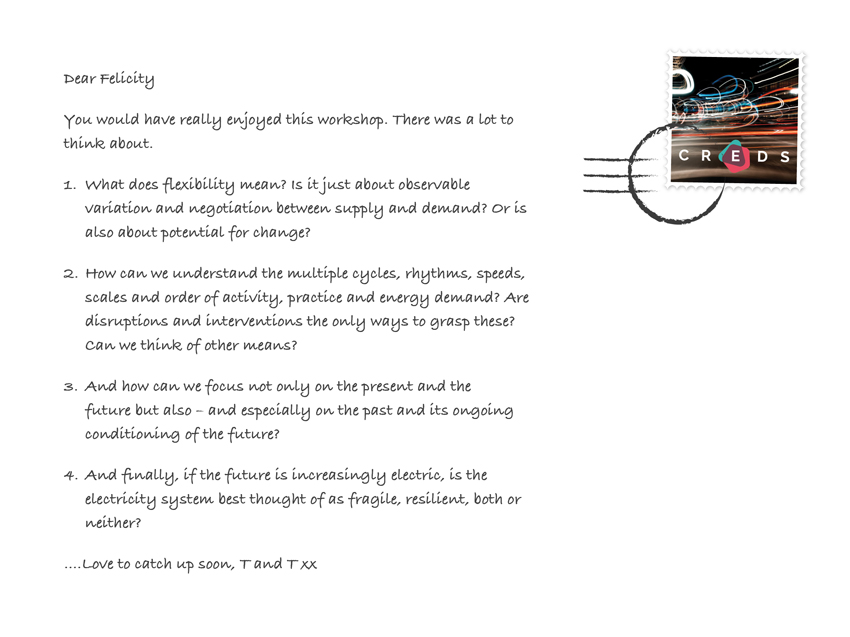
Text for postcard 3
Dear Felicity,
You would have really enjoyed this workshop. There was a lot to think about.
- What does flexibility mean? Is it just about observable variation and negotiation between supply and demand? Or is also about potential for change?
- How can we understand the multiple cycles, rhythms, speeds, scales and order of activity, practice and energy demand? Are disruptions and interventions the only ways to grasp these? Can we think of other means?
- And how can we focus not only on the present and the future but also – and especially on the past and its ongoing conditioning of the future?
- And finally, if the future is increasingly electric, is the electricity system best thought of as fragile, resilient, both or neither?
….Love to catch up soon, T and T xx
Postcard 4
The workshop inspired some people to generate new lines of enquiry. Here concepts of rhythm, contingency or synchronization are taken as given: they are not part of the debate.
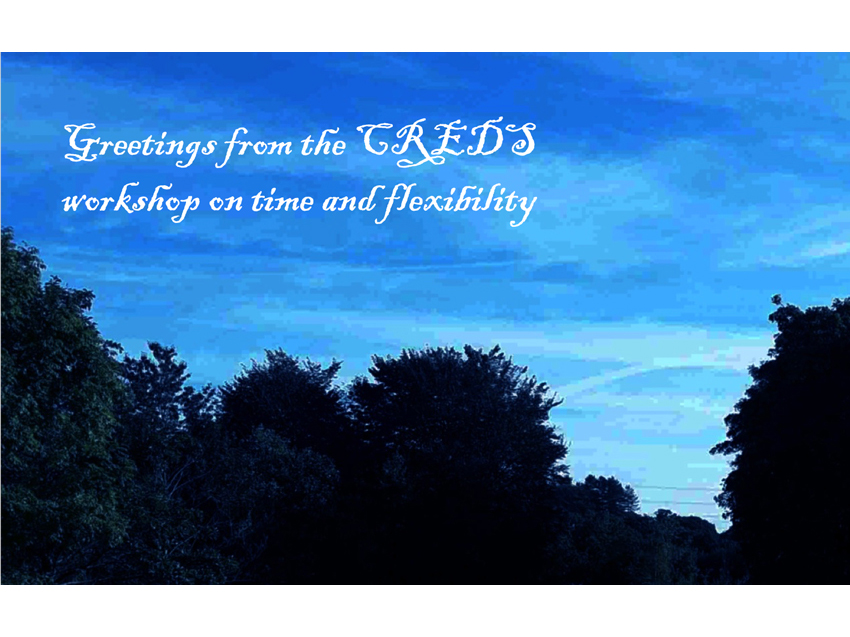
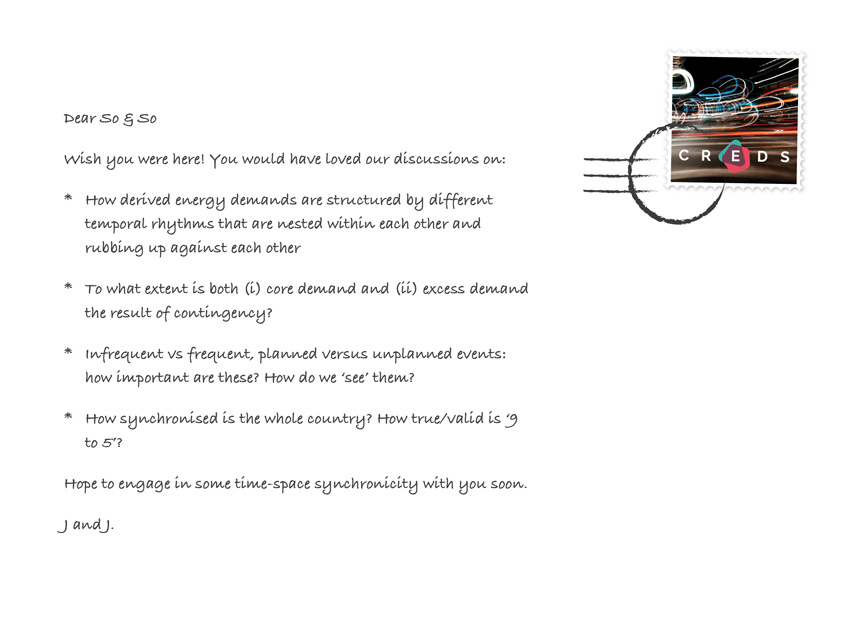
Text for postcard 4
Dear So & So,
Wish you were here! You would have loved our discussions on:
- How derived energy demands are structured by different temporal rhythms that are nested within each other and rubbing up against each other
- To what extent is both (i) core demand and (ii) excess demand the result of contingency?
- Infrequent vs frequent, planned versus unplanned events: how important are these? How do we ‘see’ them?
- How synchronised is the whole country? How true/valid is ‘9 to 5’?
Hope to engage in some time-space synchronicity with you soon.
J and J.
Postcard 5
The authors of this card reflect on the speed of research, the pace of innovation in technology and in policy, and the implications of both for energy demand reduction.
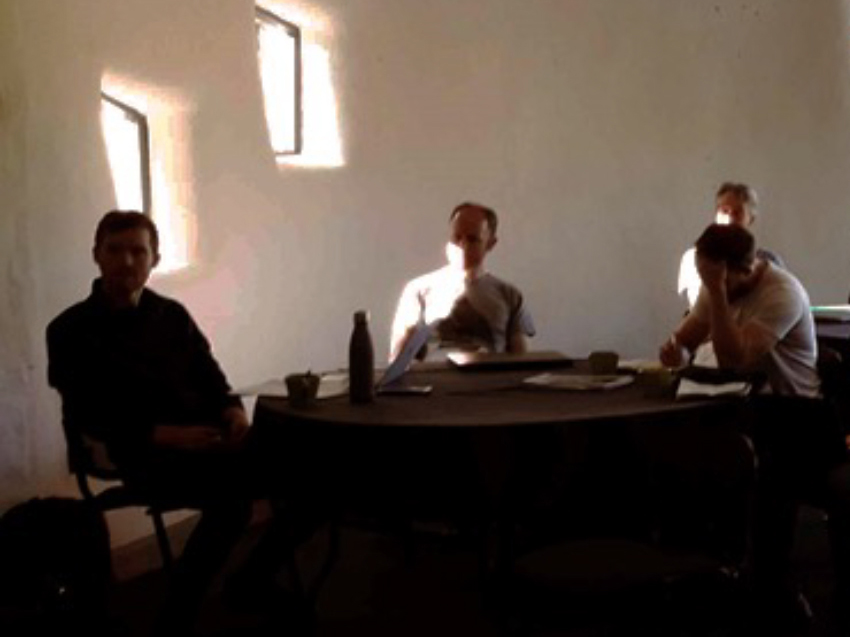
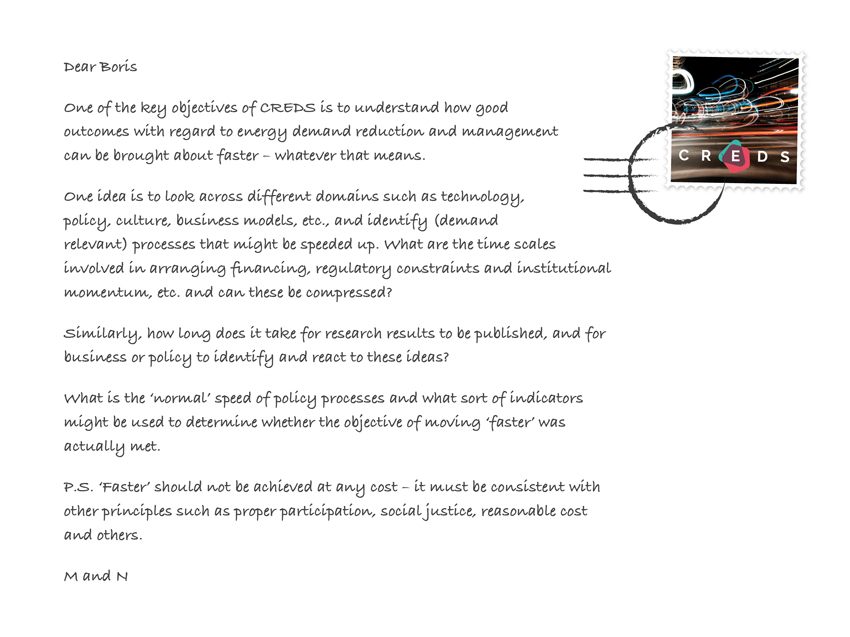
Text for postcard 5
Dear Boris,
One of the key objectives of CREDS is to understand how good outcomes with regard to energy demand reduction and management can be brought about faster – whatever that means.
One idea is to look across different domains such as technology, policy, culture, business models, etc., and identify (demand relevant) processes that might be speeded up. What are the time scales involved in arranging financing, regulatory constraints and institutional momentum, etc. and can these be compressed?
Similarly, how long does it take for research results to be published, and for business or policy to identify and react to these ideas?
What is the ‘normal’ speed of policy processes and what sort of indicators might be used to determine whether the objective of moving ‘faster’ was actually met.
P.S. ‘Faster’ should not be achieved at any cost – it must be consistent with other principles such as proper participation, social justice, reasonable cost and others.
M and N
Postcard 6
The final postcard says it all:

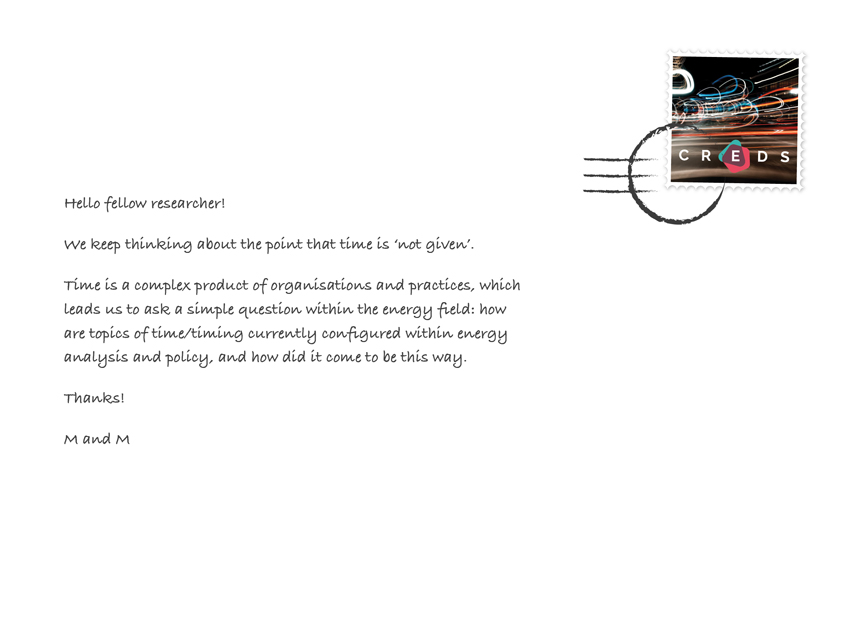
Text for postcard 6
Hello fellow researcher!
We keep thinking about the point that time is ‘not given’.
Time is a complex product of organisations and practices, which leads us to ask a simple question within the energy field: how are topics of time/timing currently configured within energy analysis and policy, and how did it come to be this way.
Thanks!
M and M
Attendees
- Jillian Anable On daily rhythms of car use
- Stan Blue Institutional rhythms
- Tiziano Cassarino Supply and demand across different time scales
- Mathieu Durand-Daubin Time use policies, energy demand and seasonal rhythms: daylight saving time
- Nick Eyre What might a flexibility policy involve?
- Tina Fawcett Time scales of buildings and energy demand
- Mike Fell Weather, climate, seconds, seasons
- Peter Forman Natural Gas, Polyrhythmia and Seasonality
- Martin Green Everyday light
- Michael Greenhough Summer: What is it and what difference does it make?
- Sarah Higginson On how ‘fast’ and ‘slow’ are conceptualised in energy policy
- Debbie Hopkins On smart and automated freight
- Samuele Lo Piano Time scales of energy transitions
- Tim Schwanen Follow the Friction: provisional notes on rhythm, in/flexibility and energy demand
- Elizabeth Shove The fixities of flexibility: ironies and implications
- Stefan Smith Time scales of energy transitions
- Jacopo Torriti
Banner photo credit: Output from Flexibility workshop



